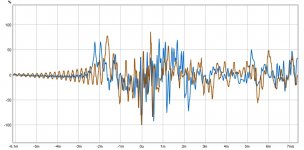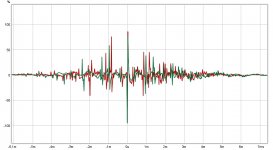That Waves plugin might be worth a try, here a very old (relatively) review of what it can do: Neural UpMix by DTS Review
If I use it purely for creating the ambient basics it could add another dimension.
Worth a try if they have a demo version, I see the new one also supports quad type 4 channel from stereo sources.
If I use it purely for creating the ambient basics it could add another dimension.
Worth a try if they have a demo version, I see the new one also supports quad type 4 channel from stereo sources.
Does it alter the info to the front mains in any way?
My implementation slightly attenuates the mains in the unsteered condition to keep the total radiated sound power the same. This ensures that the perceived volume is approximately the same as plain stereo (useful when toggling the effect on and off for A/B comparisons). I've been using -6dB for the surround level (levels are set based on steady-state response), so the gain adjustment is 10*log(1 / (1^2 + 0.5^2)) = -0.97dB. Under strong front steering, the fronts go back to full level to keep the loudness of directional signals correct at the expense of slight power error. This directional boost can be turned off if desired, in which case the only change to the mains is the attenuation.
OK, clear... so no change to the front mains, except for this balance tweak to be able to compare with/without.
Too bad the Logic 7 never made it to a vst plugin able to convert 2 to 4 or 5 channels etc.
They did seem to have a really good recipe there.
The downside you spoke of, is that the phase flip described in the paper by Griesinger? The one where full out of phase signals in main speakers switches the right ambient channel phase by 180 deg? I'll have to see what DTS Neural does in that case. Heck, I need to finish up my arrays first, then I can think of experiments again .
.
When I think about it though, it should be easy to test with Emmerson Lake and Palmer, Still... You Turn Me On.
It has the vocals that goes completely out of phase when the title sentence is sung. Very cool on a good stereo setup.
First time I listened to that song in my car (after a lot of work on the stereo) I was completely flabbergasted...
Too bad the Logic 7 never made it to a vst plugin able to convert 2 to 4 or 5 channels etc.
They did seem to have a really good recipe there.
The downside you spoke of, is that the phase flip described in the paper by Griesinger? The one where full out of phase signals in main speakers switches the right ambient channel phase by 180 deg? I'll have to see what DTS Neural does in that case. Heck, I need to finish up my arrays first, then I can think of experiments again
When I think about it though, it should be easy to test with Emmerson Lake and Palmer, Still... You Turn Me On.
It has the vocals that goes completely out of phase when the title sentence is sung. Very cool on a good stereo setup.
First time I listened to that song in my car (after a lot of work on the stereo) I was completely flabbergasted...
Last edited:
so no change to the front mains, except for this balance tweak to be able to compare with/without.
And the directional boost.
Too bad the Logic 7 never made it to a vst plugin able to convert 2 to 4 or 5 channels etc.
They did seem to have a really good recipe there.
Yeah, Lexicon has plugins for a lot of their other effects, but not the upmixer. It seems that you have to buy a hardware processor to get Logic7. You can buy the QLI-32, which has 32-channel Quantum Logic®, for only 7000 USD
The downside you spoke of, is that the phase flip described in the paper by Griesinger? The one where full out of phase signals in main speakers switches the right ambient channel phase by 180 deg?
I'm assuming you're referring to this post... No, that's a separate issue. In the default condition (fully decorrelated inputs), the surrounds just play L and R. This is required in order to get full lateral separation in the surround channels (as you noted before, the L-R scheme gives you a mono signal). This is why the steering and event detection is important. As the inputs become more correlated, the matrix coefficients change in order to cancel the directional signal.
The phase inversion you mention is because in matrix surround, the rear channels are encoded as out-of-phase information (negatively correlated, in other words). Usually this is done by applying a 90° phase shift (Hilbert transformation) to both channels and then inverting one. The 90° phase shift improves the front/back channel separation. When you want to produce localizeable sounds from the rear, the phase of one surround channel must be inverted in order so the signal is in-phase. My implementation does not handle this case because I assume that, in general, there are not supposed to be localizable sounds from the rear with normal stereo material. If I wanted to handle encoded stuff properly, I'd need to add this.
Can't wait to see what you've got  . Most of the decorrelation I have will come from using the reverb algorithm. (well, that, and their diffusive reflective nature)
. Most of the decorrelation I have will come from using the reverb algorithm. (well, that, and their diffusive reflective nature)
It will be a while before I can test anything though. My arrays are 'currently in service'. They will receive some passive frequency dependent filters an a fresh coat of paint.
After that update I'll have to redo everything.
It will be a while before I can test anything though. My arrays are 'currently in service'. They will receive some passive frequency dependent filters an a fresh coat of paint.
After that update I'll have to redo everything.
Last edited:
I've been researching decorrelation methods over the past few days and happened to find (and implement) one that seems to work pretty well as a faux stereo effect. The paper is here and there is a sound sample on the author's website. I can attach an impulse response for the effect if you want.
Alright, here you go  . I've attached 44.1kHz and 48kHz versions. Let me know if you want a different sample rate.
. I've attached 44.1kHz and 48kHz versions. Let me know if you want a different sample rate.
The average group delay is about 8.5ms, so you may want to reduce the ambience channel delay accordingly.
The average group delay is about 8.5ms, so you may want to reduce the ambience channel delay accordingly.
Attachments
Last edited:
Thanks for that, can't wait to get everything back online.
If I look at the IR's, I'm pretty sure my ambient channels are properly decorrelated as they are at present. Cool to hear the effect on the website with headphones. The side firing speakers I have, reflecting off of random nearby stuff does a good job of decorrelating as well. If I can find it I'll post an example somewhere this weekend.
If I look at the IR's, I'm pretty sure my ambient channels are properly decorrelated as they are at present. Cool to hear the effect on the website with headphones. The side firing speakers I have, reflecting off of random nearby stuff does a good job of decorrelating as well. If I can find it I'll post an example somewhere this weekend.
The decorrelator is intended to supplement some existing ambience extraction technique. A simple example would be
Basically, the decorrelator scrambles the phase of the inputs without changing the magnitude response, so a mono signal (like L-R) sounds more like stereo.
Code:
L -> L front
R -> R front
L-R -> delay -> attenuation -> impulse R -> R surround
R-L -> delay -> attenuation -> impulse L -> L surroundBasically, the decorrelator scrambles the phase of the inputs without changing the magnitude response, so a mono signal (like L-R) sounds more like stereo.
After typing the above reply, I began to wonder if the -R component should get a different delay as well, and -L for the other side. What I tried to do here is mimic, as much as possible, a passive Haas kicker. In other words, what you'd get, results wise, in a "good room".
While the active steering solutions are interesting as well, there probably is a difference on what a true diffusive (semi ideal) room would give back and these upmix utilities (my own mix included). But in any case I feel free to pick the solution that gives me the most listening pleasure . I've had different degrees of envelopment. That sure is something I love very much! As well as the holographic 3D like feel of the stage that the ambience addition can bring. It's a thrill if everything falls into place!
. I've had different degrees of envelopment. That sure is something I love very much! As well as the holographic 3D like feel of the stage that the ambience addition can bring. It's a thrill if everything falls into place!
I'm not mixing audio after all, I'm just enjoying it...
While the active steering solutions are interesting as well, there probably is a difference on what a true diffusive (semi ideal) room would give back and these upmix utilities (my own mix included). But in any case I feel free to pick the solution that gives me the most listening pleasure
I'm not mixing audio after all, I'm just enjoying it...
- Home
- Loudspeakers
- Full Range
- The making of: The Two Towers (a 25 driver Full Range line array)

